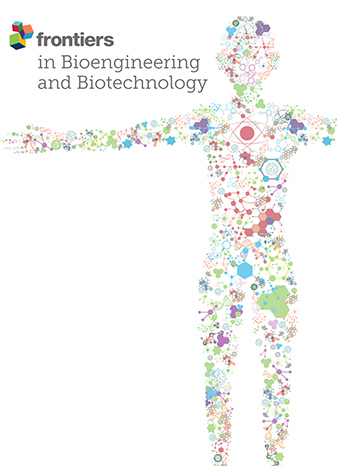通过实验和并行计算建模研究皮肤模拟物对碎片冲击的动态响应
IF 4.3
3区 工程技术
Q1 BIOTECHNOLOGY & APPLIED MICROBIOLOGY
引用次数: 0
摘要
在现代非对称战争中,碎片撞击造成的皮肤穿孔是决定受伤严重程度和丧失能力的关键因素。因此,需要根据实验数据验证计算模型,以模拟皮肤模拟物对碎片冲击的反应。为此,我们利用实验和同步计算模型来研究皮肤模拟物对碎片冲击的动态响应。本文考虑了质量为 1.10 g 和 2.79 g 的碎片模拟射弹(FSP),并从阈值速度、能量密度、峰值位移和破坏机制等方面研究了皮肤模拟物的响应。结果表明了许多突出的方面。表皮模拟物的破坏涉及空腔剪切,然后是弹性孔扩大,这些结果对应变率很敏感。当模拟输入的应力-应变曲线基于完整的应变速率谱时,模拟结果与实验结果的一致性最好。当使用与特定应变速率相对应的单一应力-应变曲线作为输入时,根据所考虑的应变速率,皮肤模拟体的阈值速度和峰值位移要么预测不足,要么预测过高。阈值速度对输入的破坏应变也很敏感;在这里,当破坏应变基于理论极限应变时,获得的一致性最好。当 FSP 材料改为塑料时,阈值速度最多增加 33%;然而,能量密度和产生的应力超过了皮肤的挫伤和撕裂阈值。本文章由计算机程序翻译,如有差异,请以英文原文为准。
Investigation of dynamic responses of skin simulant against fragment impact through experiments and concurrent computational modeling
Perforation of the skin by fragment impact is a key determinant of the severity of an injury and incapacitation during modern asymmetric warfare. Computational models validated against experimental data are thus desired for simulating the responses of a skin simulant against fragment impact. Toward this end, experiments and concurrent computational modeling were used to investigate the dynamic responses of the skin simulant against fragment impact. Fragment simulating projectiles (FSPs) of masses 1.10 g and 2.79 g were considered herein, and the responses of the skin simulant were investigated in terms of the threshold velocity, energy density, peak displacement, and failure mechanisms. The results illustrate numerous salient aspects. The skin simulant failure involved cavity shearing followed by elastic hole enlargement, and these results were sensitive to the strain rate. The best agreement between the simulated and experimental results was achieved when the input stress–strain curves to the simulation were based on the full spectrum of strain rates. When a single stress–strain curve corresponding to a specific strain rate was used as the input, the threshold velocity and peak displacement of the skin simulant were either underpredicted or overpredicted depending on the strain rate considered. The threshold velocity was also sensitive to the input failure strain; here, the best agreement was obtained when the failure strain was based on the theoretical limiting strain. When the FSP materials were changed to plastics, the threshold velocities increased by up to 33%; however, the energy densities and generated stresses exceeded the contusion and laceration thresholds of the skin.
求助全文
通过发布文献求助,成功后即可免费获取论文全文。
去求助
来源期刊

Frontiers in Bioengineering and Biotechnology
Chemical Engineering-Bioengineering
CiteScore
8.30
自引率
5.30%
发文量
2270
审稿时长
12 weeks
期刊介绍:
The translation of new discoveries in medicine to clinical routine has never been easy. During the second half of the last century, thanks to the progress in chemistry, biochemistry and pharmacology, we have seen the development and the application of a large number of drugs and devices aimed at the treatment of symptoms, blocking unwanted pathways and, in the case of infectious diseases, fighting the micro-organisms responsible. However, we are facing, today, a dramatic change in the therapeutic approach to pathologies and diseases. Indeed, the challenge of the present and the next decade is to fully restore the physiological status of the diseased organism and to completely regenerate tissue and organs when they are so seriously affected that treatments cannot be limited to the repression of symptoms or to the repair of damage. This is being made possible thanks to the major developments made in basic cell and molecular biology, including stem cell science, growth factor delivery, gene isolation and transfection, the advances in bioengineering and nanotechnology, including development of new biomaterials, biofabrication technologies and use of bioreactors, and the big improvements in diagnostic tools and imaging of cells, tissues and organs.
In today`s world, an enhancement of communication between multidisciplinary experts, together with the promotion of joint projects and close collaborations among scientists, engineers, industry people, regulatory agencies and physicians are absolute requirements for the success of any attempt to develop and clinically apply a new biological therapy or an innovative device involving the collective use of biomaterials, cells and/or bioactive molecules. “Frontiers in Bioengineering and Biotechnology” aspires to be a forum for all people involved in the process by bridging the gap too often existing between a discovery in the basic sciences and its clinical application.
 求助内容:
求助内容: 应助结果提醒方式:
应助结果提醒方式:


